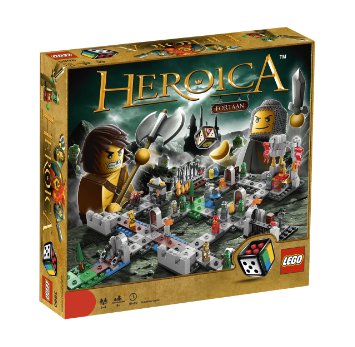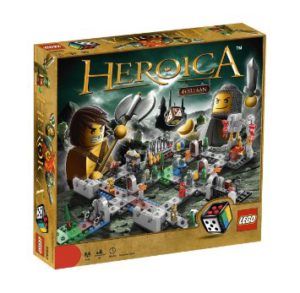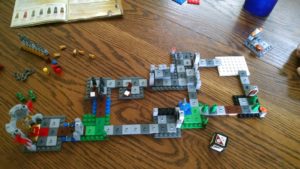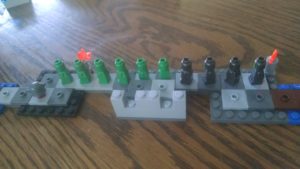
 We’ve been cleaning out the house lately, going through boxes and trying to free up some space. One of the things we found buried in the closet was the game Lego Heroica. We had gotten it years ago, long before kids, through some kind of secret Santa gift exchange or something and it had been sitting buried ever since. My son saw it in the closet, and being a lover of Lego immediately wanted to play.
We’ve been cleaning out the house lately, going through boxes and trying to free up some space. One of the things we found buried in the closet was the game Lego Heroica. We had gotten it years ago, long before kids, through some kind of secret Santa gift exchange or something and it had been sitting buried ever since. My son saw it in the closet, and being a lover of Lego immediately wanted to play.
The game is a kids game so the mechanics are pretty simple. You start out by building up a map with the included Lego pieces. They have a few included maps but you can also design your own. This is the main advantage of the game being made from Lego because it also means you can substitute in more parts from your (presumably enormous) collection.
You play one of four classic Dungeons and Dragons type characters; Barbarian, Druid, Knight, Wizard. Each has a special ability that triggers on a certain dice role that fits their theme (Druid heals, Wizard using a ranged magic attack). The die is a Lego built d6 with special sides.
 Your goal is to move through a dungeon and defeat the Goblin King or be the first to find a piece of treasure. You take turns rolling the die and moving through the dungeon. You can encounter loot, treasure chests and monsters. If you move next to a monster you have to fight it. A simple die roll will determine if you kill it, take some damage or both. Since it’s a kids game, if your characters health goes to zero you just have to spend the next few rounds healing instead of being out.
Your goal is to move through a dungeon and defeat the Goblin King or be the first to find a piece of treasure. You take turns rolling the die and moving through the dungeon. You can encounter loot, treasure chests and monsters. If you move next to a monster you have to fight it. A simple die roll will determine if you kill it, take some damage or both. Since it’s a kids game, if your characters health goes to zero you just have to spend the next few rounds healing instead of being out.
Like our experience previously with Star Wars: Empire vs Rebellion it was an instant love for my son. We’ve played it several dozen times and he’s gotten really into the building different dungeons. He enjoys finding the treasure and being able to buy new weapons with the gold you collect.
This has gotten me thinking that the game is a great introduction to the roleplay universe of gaming. It reminds me a lot of a simpler version of Hero Quest (a game I seriously regret not having kept from my childhood), which in turn, is a simpler version of Dungeons and Dragons. He’s already familiar with the concept of leveling characters and doing quests from Disney Infinity (very disappointed that got canceled).
This game adds the element of variable maps, gear and being a non-video game. This makes it a nice introduction to the core ideas of tabletop RPG’s. It is essentially a D&D dungeon crawl with all the layers removed. Walk through dungeon, kill monsters, get treasure. Repeat in whatever configuration of map you want.
A friend of mine has gotten his five year old daughter into Star Wars RPG’s using FFG’s system so my son at four is probably not far off from being old enough to handle the concept. Though I wonder about his ability to constrain his imagination to a set of rules (we pretend play Star Wars a lot and the Millenium Falcon often blows up a septillion* Star Destroyers in one shot).
 His idea of a good map and a fair game still need a little work. He’ll often make the map just a single linear line and stack all the monsters in one bunch together with all the treasure right at the start. This makes the game a bit dull to play for us adults (even duller than the simple mechanics would necessitate).
His idea of a good map and a fair game still need a little work. He’ll often make the map just a single linear line and stack all the monsters in one bunch together with all the treasure right at the start. This makes the game a bit dull to play for us adults (even duller than the simple mechanics would necessitate).
But even still, it’s a fun game for young kids as it allows for creativity, map making and serves as a good gateway drug (I’m a horrible parent) to the future of roleplay gaming.
*Yes, a septillion. A one followed by 24 zeroes (1,000,000,000,000,000,000,000,000)****. He wanted to know what a thousand thousands were (one million). This led to a million millions (one trillion). Which led to a trillion trillions (one septillion). After that names get really weird** so I stopped answering those questions.
**A septillion septillions is a quindecillion*** by the way.
***Wikipedia doesn’t tell me what a quindecillion quindecillions is. Sorry.
****This is in the American system. Europeans do it weird. Apparently a milliard comes after a million instead of a billion.

What you’re talking about in note 4 is the ‘long scale’ as opposed to the ‘short scale’ most english-speakers are familiar with. (The UK switched over in the 70s, but they usually like to just say ‘thousand million’ to avoid confusion.)
In the long scale (used in most of Europe and most French or Spanish speaking countries), each step up is a million times bigger than the previous step rather than a thousand — so you have a million, a thousand million (or ‘milliard’), and then a billion is a million million. Then you have a thousand billion (or ‘billiard’), then a trillion, thousand-trillion (or trilliard), and so on.
That’s one reason scientific papers like to use SI prefixes like “mega-“, “giga-“, and “tera-” even when it seems a bit odd to do so; there’s no confusion over what those words mean, as they’re each specifically defined as a certain power of 10. It’s strange to see galactic distances referenced as Gly (‘giga-light-years’) or deep time counted in Gya (‘giga-years-ago’), but it avoids the problem of having to wonder what kind of billion was meant.